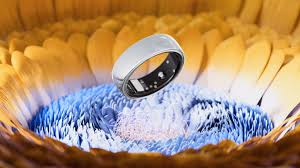
Circular ring 2 review: The smart ring market has exploded in recent years, with brands like Oura, Samsung, and Ultrahuman vying for dominance. Enter the Circular Ring 2, a next-generation wearable unveiled at CES 2025 that promises to redefine the category with its FDA-approved atrial fibrillation (AFib) detection, on-finger ECG capabilities, and innovative digital sizing technology. Priced at $349–$549 (with Kickstarter discounts), this titanium-crafted ring aims to blend luxury, health monitoring, and user-friendly design. After analyzing its features, design, and potential based on available data, here’s a comprehensive review of the Circular Ring 2 and whether it lives up to the hype.
Design and Build: A Premium Leap Forward
The Circular Ring 2 marks a significant departure from its predecessor, the Circular Ring Slim, which was criticized for its plastic-like feel and scratch-prone exterior. Circular has addressed these concerns head-on with a complete redesign:
- Material and Finishes: The Ring 2 is crafted from premium titanium, offering enhanced durability and a luxurious aesthetic. Available in four finishes—gold, silver, rose gold, and black—it competes directly with the sleek designs of the Oura Ring 4 and Samsung Galaxy Ring. The jet-black variant stands out for its understated elegance, while the gold finish adds a touch of opulence.
- Comfort and Weight: Weighing approximately 5 grams (up from the 2-gram Slim), the Ring 2 is slightly heavier to accommodate a larger battery and ECG sensors. Despite the added weight, hands-on reports suggest it remains lightweight and comfortable for all-day wear. The inner band features slightly protruding sensors, but they don’t compromise comfort.
- Durability: The titanium build addresses the Slim’s scratchability issues, and the environmental sealing has improved from IPX8 to IP68. While still not suitable for swimming, it can handle hand washing, showering, and splashes with ease.
- Charging: Circular has replaced the Slim’s clunky USB charger with a wireless charging dock, making the process simpler and more reliable. This is a welcome upgrade, as the previous charger was a pain point for users.
Verdict on Design: The Circular Ring 2 feels like a premium product, both in aesthetics and durability. It’s a massive improvement over the Slim and holds its own against competitors in the luxury smart ring space.
Features and Health Tracking: FDA-Approved Innovation
The Circular Ring 2’s headline feature is its FDA-cleared AFib detection and on-finger ECG capability, setting it apart from most smart rings on the market. Let’s break down its key features:
1. FDA-Approved AFib Detection and ECG
1-The Ring 2 is one of the first smart rings to offer onboard ECG readings, a feature typically reserved for high-end smartwatches like the Samsung Galaxy Watch 7 or Apple Watch. Users can perform a 30-second ECG by holding their finger on the ring, providing real-time heart rhythm analysis.
2-The FDA-cleared AFib detection algorithm, developed in partnership with B-Heart, monitors for irregular heartbeats that could indicate atrial fibrillation—a condition that increases the risk of stroke and heart failure. At launch, it supports active AFib detection, with plans for passive monitoring (using PPG sensors to prompt ECGs) via future OTA updates.
3-Unlike the Ultrahuman Ring Air, which requires a subscription for AFib detection, the Circular Ring 2 offers this feature subscription-free, adding significant value.
2. Enhanced Health Tracking
Sensors: The Ring 2 boasts upgraded photoplethysmography (PPG) sensors for more accurate heart rate, heart rate variability (HRV), blood oxygen (SpO2), and sleep tracking. Additional sensors improve holistic tracking accuracy compared to the Slim, which was sometimes off by 5,000 steps in testing.

Sleep Analysis: The ring tracks sleep stages (REM, light, deep, awake) and provides detailed insights, competing with the Oura Ring 4’s robust sleep metrics.

Activity and Stress: It monitors steps, calories burned, and stress levels, offering AI-powered insights via the revamped Kira AI assistant. The calibration period for personalized recommendations has been reduced from 14 days to 4 days, making it more user-friendly.

Future Features: Circular claims the Ring 2 will support blood pressure trend tracking by late 2025 and blood glucose trend monitoring by late 2026, using ECG and PPG sensors. These would be groundbreaking for a smart ring, but given the challenges of cuffless blood pressure and non-invasive glucose monitoring, skepticism is warranted until proven.

3. Digital circular Ring 2 Sizing
One of the Ring 2’s most innovative features is its digital sizing system, which uses a smartphone camera and AI to measure finger size. Users place their hand next to a credit card for scale, and the app recommends a size in seconds. This eliminates the need for wasteful plastic sizing kits, reduces environmental impact, and speeds up the ordering process. Hands-on tests at CES 2025 confirmed its accuracy, though it’s unclear how it accounts for daily finger swelling.

4. Circular ring 2 Battery Life
Circular promises up to 8 days of battery life in eco mode (limited tracking) and 4–6 days in performance mode (full tracking). This is a significant improvement over the Slim’s 2–5 days and aligns with competitors like the Oura Ring 4.
The wireless charging dock further enhances convenience, ensuring users can easily keep the ring powered.
Performance and Accuracy: A Work in Progress
The Circular Ring Slim faced criticism for inaccurate tracking (e.g., step counts off by thousands) and connectivity issues. Circular claims the Ring 2’s upgraded sensor array and software improvements resolve these problems:
- Accuracy: Early hands-on reports from CES 2025 suggest the Ring 2 is far more accurate than the Slim, with PPG sensors providing reliable heart rate and SpO2 readings. The ECG feature has undergone rigorous FDA testing, ensuring medical-grade accuracy for AFib detection.
- Connectivity: Background syncing issues that plagued the Slim have reportedly been fixed, allowing seamless data transfer to the app.
- Real-World Testing: Since the Ring 2 is not yet widely available, comprehensive performance data is limited. Full reviews are expected after its March 2025 launch, but initial impressions are promising.
Pricing and Availability
- Price: The Circular Ring 2 starts at $349 (via Kickstarter) but retails at $549, with discounts up to $310 for early backers. This makes it comparable to the Oura Ring 4 ($349) and Samsung Galaxy Ring ($399.99).
- Subscription-Free: Unlike Oura, which requires a $5.99/month subscription for full features, the Ring 2 is subscription-free, offering long-term savings.
- Availability: Launched via a Kickstarter campaign in January 2025, the Ring 2 is expected to ship in March or June 2025, depending on the source. It will be available in the US, UK, France, and other markets.
- Crowdfunding Risk: As a crowdfunded product, there’s a slight risk of delays or production issues, as seen with the Slim. However, Circular’s experience and CES buzz suggest confidence in delivery.
Verdict on Pricing: The Ring 2’s price is competitive, especially with no subscription fees. Kickstarter discounts make it an attractive option, but potential buyers should be aware of crowdfunding uncertainties.
Who Is It For?
The Circular Ring 2 is ideal for:
- Health-Conscious Users: Those prioritizing heart health monitoring, especially with AFib risks, will appreciate the FDA-cleared ECG.
- Tech Enthusiasts: Early adopters excited about innovative features like digital sizing and potential blood pressure/glucose tracking.
- Style-Conscious Buyers: The titanium design and color options appeal to those wanting a fashionable wearable.
- Budget-Conscious Long-Term Users: The subscription-free model saves money compared to Oura.
It may not suit:
- Swimmers or Athletes: The IP68 rating isn’t swim-proof, unlike Oura or Samsung.
- Risk-Averse Buyers: Crowdfunding uncertainties may deter those preferring established products.





